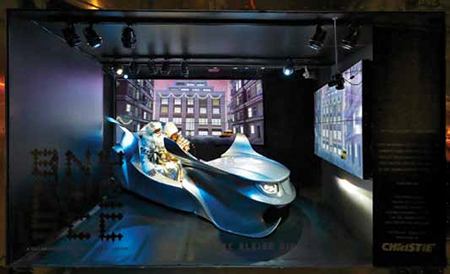Projection Mapping is getting better and easier, and seems to finally be moving past its novelty stage. Calibration improvements, combined with the use of 3D geometry allows designers to get pixel-precise mappings onto even the most complex of objects. Take for instance the Rowdytown II rock mapping above or the intricate Universal Mind project:
Even the slightest mis-registration here, and the whole experience could be ruined! Similarly, the Rowdytown mapping required numerous projectors, and in the most dense area, five 40,000 lumen Barco HDQ2K40 projectors were stacked, calibrated and aligned perfectly so the projection was not blurred by mis-registration and bright enough even with daylight.
Historically, projection mapping has been used in car and trade shows and on eye-catching buildings. Yet now, the possibilities become endless as all objects have the potential to be mapped onto. In the lesser-tapped markets of North and South America, we’re finally seeing projection mapping used outside of these larger niche markets. For example, Barneys New York recently added several projection-mapped pieces to their BNY SCC Gallery for advertising and retail purposes (below).
Other new markets include dining options, in-home entertainment, and making sports arenas (like courts and fields) appear 3D and more immersive. The field is also seeing an increased number of requests by artists and designers, who want to transform even more public spaces for the enjoyment of others. These kinds of possibilities will only become more widely available with better software and hardware, ultimately driving costs down making projection mapping more and more common.
What do you think? Is projection mapping on the horizon of becoming a traditional form of media, or even becoming household technology?
